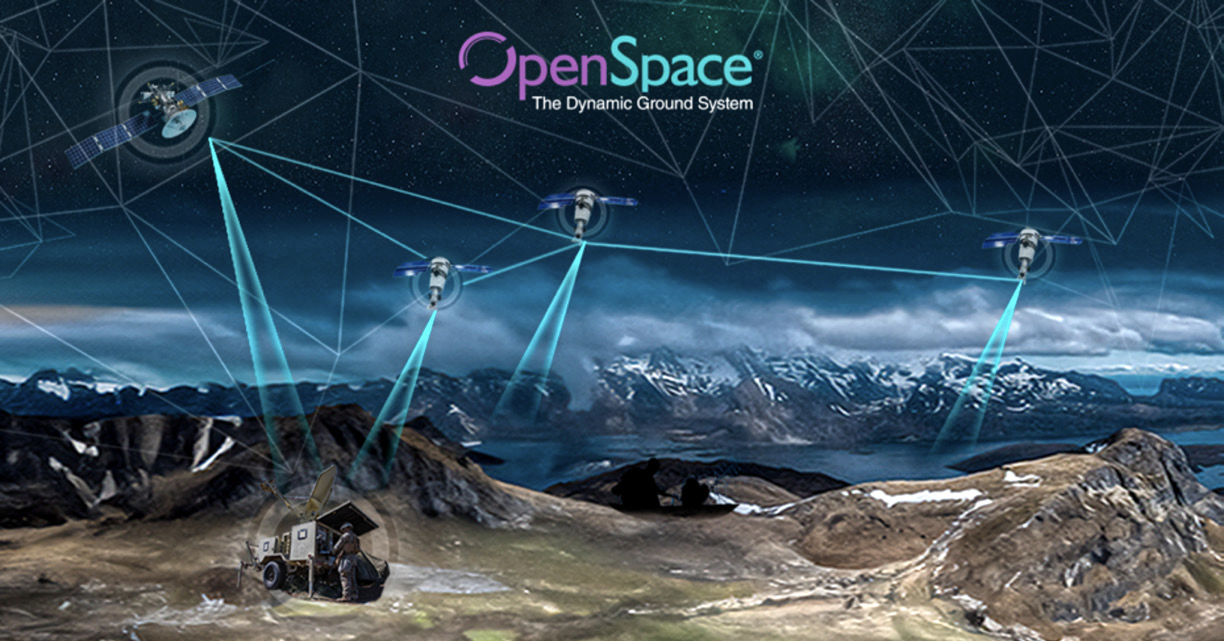Kratos Space Editorial Team.
Transforming
Ground with
Software
Traditional satellite ground stations are based on decades of customized hardware built for a singular mission or purpose. However, adversaries are driving traditional ground stations to quickly adapt in form and function.

Figure 1: The virtual ground will connect military and
commercial operations for a competitive edge
To stay ahead, military ground systems require advanced capabilities that are flexible, scalable and capable of supporting multiple missions. A commercially available, fully software-defined satellite ground system that leverages virtualization, orchestration, cloud computing and open architecture will be a way for the military to maintain its competitive edge. The seamless integration of LEO, MEO and GEO satellites provides a level of resiliency previously unattainable in military satellite communications.
Software-Defined
Solutions for
National Defense
At the 2024 Space Symposium, Kratos announced that the company’s fully virtualized satellite communications (SATCOM) ground system, OpenSpace®, was employed as part of BlueHalo’s milestone demonstration for the U.S. Space Force (USSF) Space Rapid Capabilities Office (RCO) Satellite Communication Augmentation Resource (SCAR) program.
Kratos’ OpenSpace Platform is an important component of the backend system that will pair with BlueHalo’s BADGER adaptive phased array product to provide multi-beam, multi-orbit mission operations.
Additionally, the Space Development Agency (SDA) announced an approx. $117 million contract to Kratos for Advanced Fire Control Ground Infrastructure (AFCGI) to support demonstrations and potential future operations under the agency’s Advanced Fire Control (AFC) effort.
As a new member of #TeamSDA and the AFCGI vendor, Kratos will lead a team of industry performers to provide a common, enduring ground infrastructure and resources to minimize cost and complexity for multiple AFC prototype efforts.
Kratos’ involvement in federal programs this year demonstrates why the military is increasingly adopting software-defined solutions. These software systems promise enhanced flexibility, enabling rapid adaptation to evolving mission requirements.

Figure 2: 5G enhances accessibility and reduces latency
in military operations, giving a strategic edge in
modern warfare
The Role of 5G
and Emerging
Technologies
Kratos also forged new ground this year with its partnerships to develop 5G-NTN (non-terrestrial network) solutions for satellite connectivity. The high-speed, low-latency capabilities of 5G enhance ground station performance, enabling real-time data processing and edge computing.
This technology is revolutionizing battlefield connectivity, offering rapid deployment capabilities and extending internet access to remote regions, such as the coverage provided by terrestrial 5G networks.
Advancing Military
Resiliency Through
Software
Kratos successfully demonstrated a fully virtualized SATCOM ground system for the U.S. Army’s Program Executive Office Command, Control, Communications-Tactical (PEO C3T). Using the OpenSpace® platform, the demonstration showcased real-time adaptability to dynamic battlefield environments.
This software-driven approach enables faster deployment of new capabilities, ensuring military systems remain responsive and mission-ready.
Driving Cost
Efficiency and
Affordability
During the 2024 Air, Space & Cyber Conference, Kratos Vice President, Robert “Otis” Winkler ,emphasized the importance of affordability and survivability in military technologies. A virtual ground addresses these challenges by reducing the reliance on hardware upgrades and replacement, instead relying on software updates to manage diverse satellite system. This approach not only minimizes cost, but also streamlines resource management across military networks.

Figure 3: OpenSpace® brings versatility and
adaptability to the satellite ground network
Bridging Military
and Commercial
Sectors
Phil Carrai, President of the Space, Training & Cyber Division, Kratos, moderated a panel at the Milsat Symposium, focusing on the convergence of commercial and military sectors in a multi-orbit, multi-mission network environment.
The panel highlighted the growing need for seamless communication between commercial and military systems, enabled by open architecture adhering to industry standards. Such integration allows military operations to securely exchange data across commercial satellite networks and facilitates the unification of LEO, MEO and GEO satellites from diverse constellations.


This convergence underscores a pivotal shift in defense strategy, where the integration of commercial capabilities enhances military operations.
By leveraging open standards, the military can deploy systems that are interoperable and resilient, ensuring secure and efficient communication in dynamic scenarios.
As 2025 approaches, the advancements driven by Kratos and its technology signal a shift in military ground system operations. By embracing software-defined solutions, the military will not only future proof its operations, but ensure it remains agile, resilient and ready for what’s next.
www.kratosdefense.com

